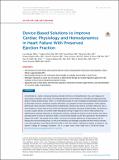Notice
This is not the latest version of this item. The latest version can be found at:https://dspace.mit.edu/handle/1721.1/138906.2
Device-Based Solutions to Improve Cardiac Physiology and Hemodynamics in Heart Failure With Preserved Ejection Fraction
| dc.contributor.author | Rosalia, Luca | |
| dc.contributor.author | Ozturk, Caglar | |
| dc.contributor.author | Shoar, Saeed | |
| dc.contributor.author | Fan, Yiling | |
| dc.contributor.author | Malone, Grainne | |
| dc.contributor.author | Cheema, Faisal H | |
| dc.contributor.author | Conway, Claire | |
| dc.contributor.author | Byrne, Robert A | |
| dc.contributor.author | Duffy, Garry P | |
| dc.contributor.author | Malone, Andrew | |
| dc.contributor.author | Roche, Ellen T | |
| dc.contributor.author | Hameed, Aamir | |
| dc.date.accessioned | 2022-01-13T15:26:49Z | |
| dc.date.available | 2022-01-13T15:26:49Z | |
| dc.date.issued | 2021 | |
| dc.identifier.uri | https://hdl.handle.net/1721.1/138906 | |
| dc.description.abstract | Characterized by a rapidly increasing prevalence, elevated mortality and rehospitalization rates, and inadequacy of pharmaceutical therapies, heart failure with preserved ejection fraction (HFpEF) has motivated the widespread development of device-based solutions. HFpEF is a multifactorial disease of various etiologies and phenotypes, distinguished by diminished ventricular compliance, diastolic dysfunction, and symptoms of heart failure despite a normal ejection performance; these symptoms include pulmonary hypertension, limited cardiac reserve, autonomic imbalance, and exercise intolerance. Several types of atrial shunts, left ventricular expanders, stimulation-based therapies, and mechanical circulatory support devices are currently under development aiming to target one or more of these symptoms by addressing the associated mechanical or hemodynamic hallmarks. Although the majority of these solutions have shown promising results in clinical or preclinical studies, no device-based therapy has yet been approved for the treatment of patients with HFpEF. The purpose of this review is to discuss the rationale behind each of these devices and the findings from the initial testing phases, as well as the limitations and challenges associated with their clinical translation. | en_US |
| dc.language.iso | en | |
| dc.publisher | Elsevier BV | en_US |
| dc.relation.isversionof | 10.1016/J.JACBTS.2021.06.002 | en_US |
| dc.rights | Creative Commons Attribution-NonCommercial-NoDerivs License | en_US |
| dc.rights.uri | http://creativecommons.org/licenses/by-nc-nd/4.0/ | en_US |
| dc.source | Elsevier | en_US |
| dc.title | Device-Based Solutions to Improve Cardiac Physiology and Hemodynamics in Heart Failure With Preserved Ejection Fraction | en_US |
| dc.type | Article | en_US |
| dc.identifier.citation | Rosalia, Luca, Ozturk, Caglar, Shoar, Saeed, Fan, Yiling, Malone, Grainne et al. 2021. "Device-Based Solutions to Improve Cardiac Physiology and Hemodynamics in Heart Failure With Preserved Ejection Fraction." JACC: Basic to Translational Science, 6 (9-10). | |
| dc.relation.journal | JACC: Basic to Translational Science | en_US |
| dc.eprint.version | Final published version | en_US |
| dc.type.uri | http://purl.org/eprint/type/JournalArticle | en_US |
| eprint.status | http://purl.org/eprint/status/PeerReviewed | en_US |
| dc.date.updated | 2022-01-13T14:52:58Z | |
| dspace.orderedauthors | Rosalia, L; Ozturk, C; Shoar, S; Fan, Y; Malone, G; Cheema, FH; Conway, C; Byrne, RA; Duffy, GP; Malone, A; Roche, ET; Hameed, A | en_US |
| dspace.date.submission | 2022-01-13T14:53:00Z | |
| mit.journal.volume | 6 | en_US |
| mit.journal.issue | 9-10 | en_US |
| mit.license | PUBLISHER_CC | |
| mit.metadata.status | Authority Work and Publication Information Needed | en_US |
